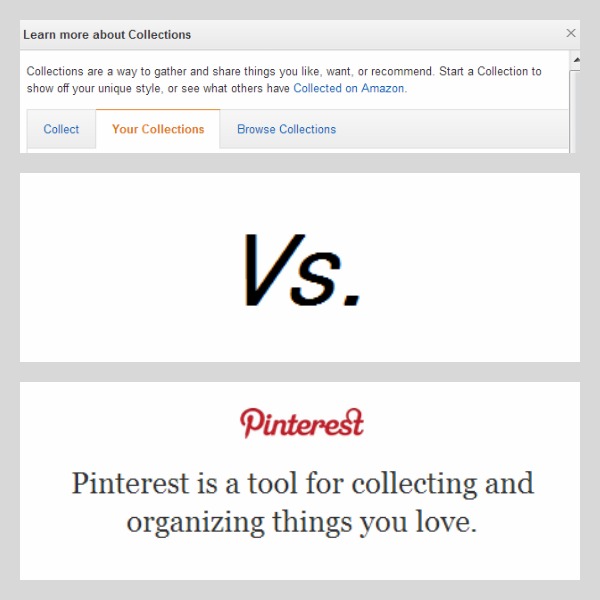Pin-Off: Amazon Collections Vs. Pinterest

If imitation is the sincerest form of flattery, Pinterest just received a huge compliment from Amazon.
This is because the ecommerce juggernaut has quietly launched a Pinterest-style service dubbed Amazon Collections. The service features a visual way for consumers to discover, save and share items that they like, want or would like to recommend. Although that sounds very familiar, the service does have some notable differences when compared to Pinterest. Let's take a closer look at these two pin-boarding sites below:
The Collection Method
Part of what has made Pinterest so successful is the ease at which users can add content to their boards. For instance, Pinterest has the "Pin It" bookmarklet button and Chrome extension that users can add to their browser. By doing this, consumers can click the button when they find an image or video that they would like to pin from anywhere around the Web. Additionally, many site owners (especially ecommerce merchants) include a "Pin It" widget on their site to make it easy for visitors to share their products, which is not only convenient for Pinterest users, but also provides merchants with free word-of-mouth advertising.
Conversely, Amazon has started rolling out an "Add to Collection" button on product pages, which makes it simple for consumers to save products while browsing around Amazon's site. That said, not every product page has this button yet since Collections is a new feature, which is why Amazon has also launched the "Collect" button that can be added to the browser. Amazon currently only allows users to collect items from Amazon.com, while Pinterest users are able to pin any type of content from around the Web.
Save-able (or Pin-able) Content
Part of Pinterest's appeal is that it is influential in driving referral traffic to merchant's websites. In fact, Piquora reports that 95 percent of pins go into boards named after categories, such as "accessories" and "furniture", while 5 percent go into very explicit commerce intent boards like "want" and "own". That said, people also save many non-commerce items to Pinterest, such as memes and recipes. Amazon Collections, on the other hand, is solely focused on ecommerce, as can be gleaned from the platform's collect button that only works on Amazon.com.
The Social Aspect
Anyone who uses Pinterest knows that it is a very active social network. After all, most users sign up to the service by connecting their Facebook or Twitter account to it. By doing so, Pinterest enables users to discover and follow their friends' activities. Amazon Collections, however, currently doesn't have an emphasis on social. Although users can view recently collected items from other Amazon users, as well as follow those users by clicking on their names, there is no discovery option yet that allows consumers to connect their address book or social credentials in order to follow and share products with their friends outside of Amazon. Don't be surprised if this changes, as it is more engaging to save and share items with a community of friends rather than strangers.
Potential for Merchants
We already know that Pinterest is a valuable social network for retailers, and it continues to improve its ecommerce capabilities by adding tools exclusively for merchants. For example, the platform offers analytics and rich product pins, which allow merchants to include real-time pricing and availability to their items that consumers pin. Plus, Pinterest announced last week that rich product pins would start alerting Pinterest users via email when there has been a price drop on items that they've pinned, which provides merchants with even greater conversion opportunities. Yet, one question remains: What does Amazon Collections mean for merchants?
For one thing, it means that merchants should have a presence on Amazon if they don't already. Amazon is already the Net's most popular marketplace, and if Amazon Collections gains steam, it could prove to be a very valuable way for merchants to obtain visibility for their products. In addition, merchants who already have a presence on Amazon should start using Amazon Collections immediately, as well as ask their friends and families to do so, so they can gain followers and build interactions with their products sooner rather than later. It is also important to note that this service could have an impact on holiday shopping, as it should prove to be a handy tool for Amazon shoppers who are considering gifting options. Plus, Amazon's users are very diverse, whereas Pinterest is female dominated. If Amazon adds tools, such as product email alerts, the service could end up being a real competitor for Pinterest. That said, it is certainly too early to tell how this service will impact the ecommerce industry, but merchants who are prepared will definitely be a step ahead of the competition.
(In the image below, see how similar Amazon Collections is to Pinterest)









